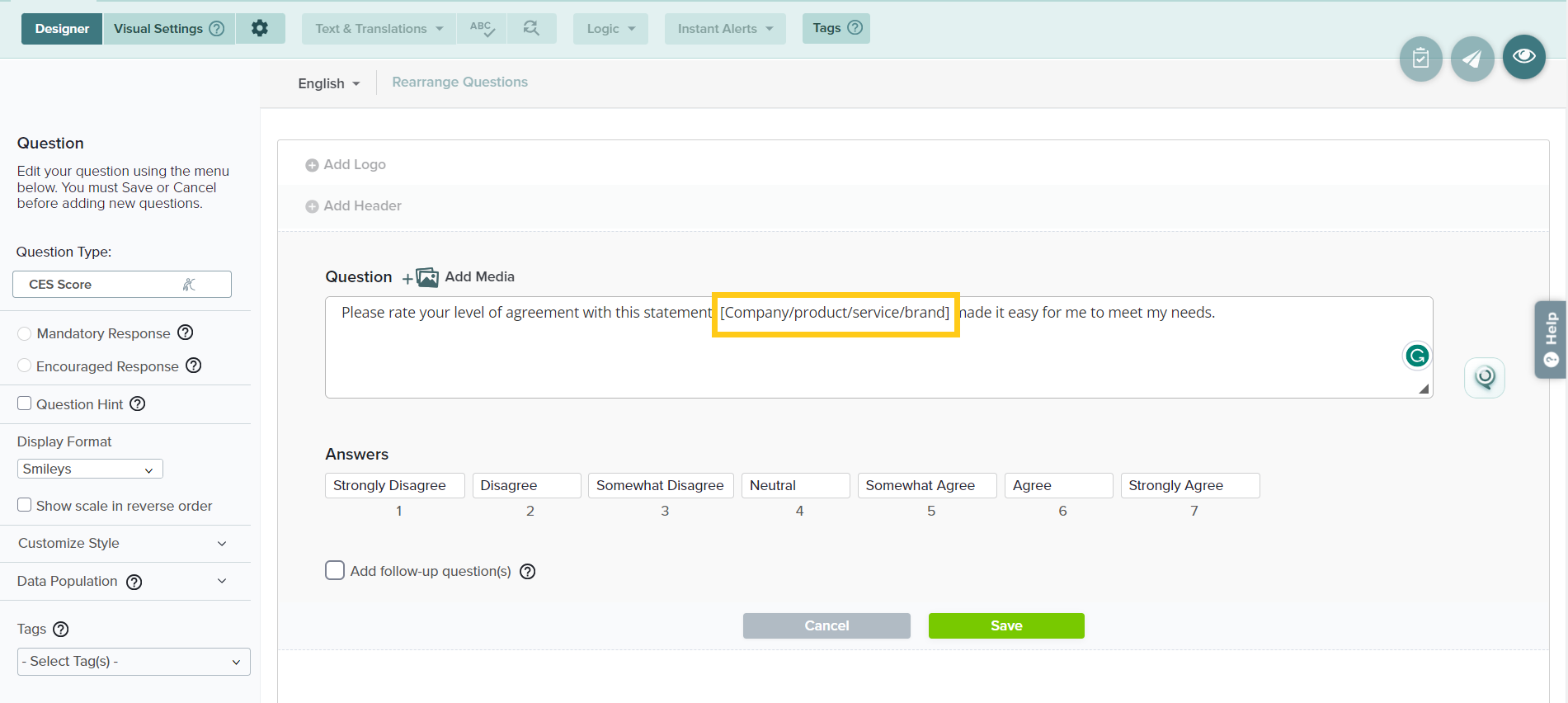Customer Effort Score – CES
Interested in reducing customer churn, improving retention, and building loyalty? Customer Effort Score, or CES, is an important metric to consider in improving your customer experience and bottom line revenue, too.
CES: Understanding the Customer Effort Score
The CES question is used to measure how helpful your organization is in enabling customers to resolve issues or obtain services. While there are many ways to ask this question, the core goal is to understand whether customers find it easy or difficult to accomplish their goals. For example, is it easy for your customers to sign up for your service? You might think so, but if your customers don’t agree, you’re heading for a disconnect!
Keep in mind that the customer’s effort should be as low as possible, which can make interpreting CES score a little tricky. At Sogolytics, we believe that the responsibility of a smooth customer experience lies with the company — not the customer. So, rather than asking ‘How easy was it for you?’, which suggests that it’s up to the customer to get the job done, we ask (paraphrasing!) ‘Did we make it easy for you?’ Based on this structure, a high score means the company’s doing a good job in making things simple for the customer.
Building Effective CES Questions
Add a CES question by dragging and dropping it from the question menu on the left. Text for the CES question is automatically generated. We strongly recommend that you use the default text. The only change you should make is to insert the name of your brand, company, or service.

Answer choices are graded on a 1 to 7 scale, where 1 represents Strongly Disagree and 7 represents Strongly Agree. The scale for a CES question cannot be changed. However, if needed, you can reverse the scale as 7 to 1.
Analyzing CES Responses: Agree, Neutral, Disagree
The CES question asks customers to rate their level of agreement with the statement: ‘The company made it easy for me to meet my needs.’ on a scale of 1 to 7. Responses categorize customers as follows:
- Agree: Customers who provide responses from 5 to 7. These are respondents who say that it was easy to deal with your company/product/service and that it took little or no effort to accomplish their goals.
- Neutral: Customers who choose 4. These are unenthusiastic customers. They may defect to competitors if they see any available benefits.
- Disagree: Customers who pick 1 to 3. These are customers who feel that it took from some to a considerable amount of effort to deal with the company/product/service in meeting their goals.

How to Calculate Customer Effort Score:
To calculate CES, the sum of scores is divided by the total number of scores/responses received.
CES = Sum of Scores/Number of Scores OR Number of Responses
The Customer Effort Score can range from 1 (all Strongly Disagree) to 7 (all Strongly Agree).
CES Score Analysis:
- A CES greater than 5, shown in green, indicates that most customers found it extremely easy to use your product or service.
- A CES between 3 and 5, shown in orange, indicates that most customers found it neither especially easy or difficult to use your product or service.
- A CES below 3, shown in red, indicates that most customers found it difficult to use your product or service.
Learn more about adding Tags to your metric questions to analyze data on the CX Dashboard.
Frequently Asked Questions: CES
1. What is a good Customer Effort Score?
A good CES is in the top half of the 1-7 scale, so anywhere from 5-7 is positive. In Sogolytics, a CES (sometimes ‘CES score’) of 5 or above is shown in green. This question may be asked as part of a broader customer feedback survey or as a standalone CES survey.
2. What is the CES scoring system?
The idea behind Customer Effort Score is pretty simple. The core question here is about how easy you as a company make it for your consumers to achieve their goals. In general, the easier you make it for your customers to do what they need to do, the happier they will be. To paraphrase, the question asks ‘Do you agree that we made it easy for you?’ Customers who agree (5-7 on a 7-point scale) and a Customer Effort Score Survey tool turns the results into an overall CES.
3. How do you calculate CES survey scores?
Customer Effort Score takes answers from the 1-7 CES score range, adds them all up, and divides by the total number of responses received. This is a simple average of all responses received. Your Customer Effort Score survey software should do the math for you. 🙂
4. How can I improve my CES?
How to improve CES score comes down to Key Drivers. Once you’ve identified the reasons behind your current CES, you can take action to make improvements that will streamline your customers’ experiences and make things easier. The good news is that Customer Effort Score Survey tools like Sogolytics can help you uncover the most valuable action items automatically! Learn more about Key Driver Analysis here, then use Predictive Analytics to see how impactful each improvement might be.
5. Is CES a percentage?
No, Customer Effort Score (or, commonly, ‘CES score’) is a number resulting from the average ratings received on a 1-7 CES scoring system. CES, unlike other CX metrics, takes into account every score received and the Customer Effort Score survey software delivers an overall CES.
Within this question type, the following options are available:
- Mandatory Response: Require participants to respond to a critical question.
- Encouraged Response: Nudge participants who skip a question to reconsider by displaying a customized request message.
- Data Population: Pre-fill answer(s) during distribution or complete post-participation.
- Question Hint: Add extra information that can help provide clarification for participants.
- Show scale in reverse order.
- Display Format: Set display format as smileys or smiley sliders.
- Customize Style: Choose from a list of smiley scale types.
Subscribe for tips and insights to drive better decisions!







